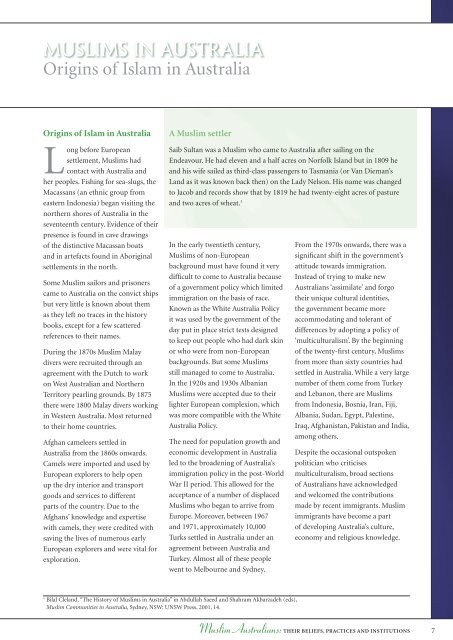Muslim Australians - Religion Cultural Diversity Resource Manual
http://www.islamicglobe.com
http://www.islamicglobe.com
You also want an ePaper? Increase the reach of your titles
YUMPU automatically turns print PDFs into web optimized ePapers that Google loves.
MUSLIMS IN AUSTRALIA<br />
Origins of Islam in Australia<br />
Origins of Islam in Australia<br />
Long before European<br />
settlement, <strong>Muslim</strong>s had<br />
contact with Australia and<br />
her peoples. Fishing for sea-slugs, the<br />
Macassans (an ethnic group from<br />
eastern Indonesia) began visiting the<br />
northern shores of Australia in the<br />
seventeenth century. Evidence of their<br />
presence is found in cave drawings<br />
of the distinctive Macassan boats<br />
and in artefacts found in Aboriginal<br />
settlements in the north.<br />
Some <strong>Muslim</strong> sailors and prisoners<br />
came to Australia on the convict ships<br />
but very little is known about them<br />
as they left no traces in the history<br />
books, except for a few scattered<br />
references to their names.<br />
During the 1870s <strong>Muslim</strong> Malay<br />
divers were recruited through an<br />
agreement with the Dutch to work<br />
on West Australian and Northern<br />
Territory pearling grounds. By 1875<br />
there were 1800 Malay divers working<br />
in Western Australia. Most returned<br />
to their home countries.<br />
Afghan cameleers settled in<br />
Australia from the 1860s onwards.<br />
Camels were imported and used by<br />
European explorers to help open<br />
up the dry interior and transport<br />
goods and services to different<br />
parts of the country. Due to the<br />
Afghans’ knowledge and expertise<br />
with camels, they were credited with<br />
saving the lives of numerous early<br />
European explorers and were vital for<br />
exploration.<br />
A <strong>Muslim</strong> settler<br />
Saib Sultan was a <strong>Muslim</strong> who came to Australia after sailing on the<br />
Endeavour. He had eleven and a half acres on Norfolk Island but in 1809 he<br />
and his wife sailed as third-class passengers to Tasmania (or Van Dieman’s<br />
Land as it was known back then) on the Lady Nelson. His name was changed<br />
to Jacob and records show that by 1819 he had twenty-eight acres of pasture<br />
and two acres of wheat. 1<br />
In the early twentieth century,<br />
<strong>Muslim</strong>s of non-European<br />
background must have found it very<br />
difficult to come to Australia because<br />
of a government policy which limited<br />
immigration on the basis of race.<br />
Known as the White Australia Policy<br />
it was used by the government of the<br />
day put in place strict tests designed<br />
to keep out people who had dark skin<br />
or who were from non-European<br />
backgrounds. But some <strong>Muslim</strong>s<br />
still managed to come to Australia.<br />
In the 1920s and 1930s Albanian<br />
<strong>Muslim</strong>s were accepted due to their<br />
lighter European complexion, which<br />
was more compatible with the White<br />
Australia Policy.<br />
The need for population growth and<br />
economic development in Australia<br />
led to the broadening of Australia’s<br />
immigration policy in the post-World<br />
War II period. This allowed for the<br />
acceptance of a number of displaced<br />
<strong>Muslim</strong>s who began to arrive from<br />
Europe. Moreover, between 1967<br />
and 1971, approximately 10,000<br />
Turks settled in Australia under an<br />
agreement between Australia and<br />
Turkey. Almost all of these people<br />
went to Melbourne and Sydney.<br />
From the 1970s onwards, there was a<br />
significant shift in the government’s<br />
attitude towards immigration.<br />
Instead of trying to make new<br />
<strong>Australians</strong> ‘assimilate’ and forgo<br />
their unique cultural identities,<br />
the government became more<br />
accommodating and tolerant of<br />
differences by adopting a policy of<br />
‘multiculturalism’. By the beginning<br />
of the twenty-first century, <strong>Muslim</strong>s<br />
from more than sixty countries had<br />
settled in Australia. While a very large<br />
number of them come from Turkey<br />
and Lebanon, there are <strong>Muslim</strong>s<br />
from Indonesia, Bosnia, Iran, Fiji,<br />
Albania, Sudan, Egypt, Palestine,<br />
Iraq, Afghanistan, Pakistan and India,<br />
among others.<br />
Despite the occasional outspoken<br />
politician who criticises<br />
multiculturalism, broad sections<br />
of <strong>Australians</strong> have acknowledged<br />
and welcomed the contributions<br />
made by recent immigrants. <strong>Muslim</strong><br />
immigrants have become a part<br />
of developing Australia’s culture,<br />
economy and religious knowledge.<br />
1<br />
Bilal Cleland, “The History of <strong>Muslim</strong>s in Australia” in Abdullah Saeed and Shahram Akbarzadeh (eds),<br />
<strong>Muslim</strong> Communities in Australia, Sydney, NSW: UNSW Press, 2001, 14.<br />
<strong>Muslim</strong> <strong>Australians</strong>:THEIR BELIEFS, PRACTICES AND INSTITUTIONS 7














